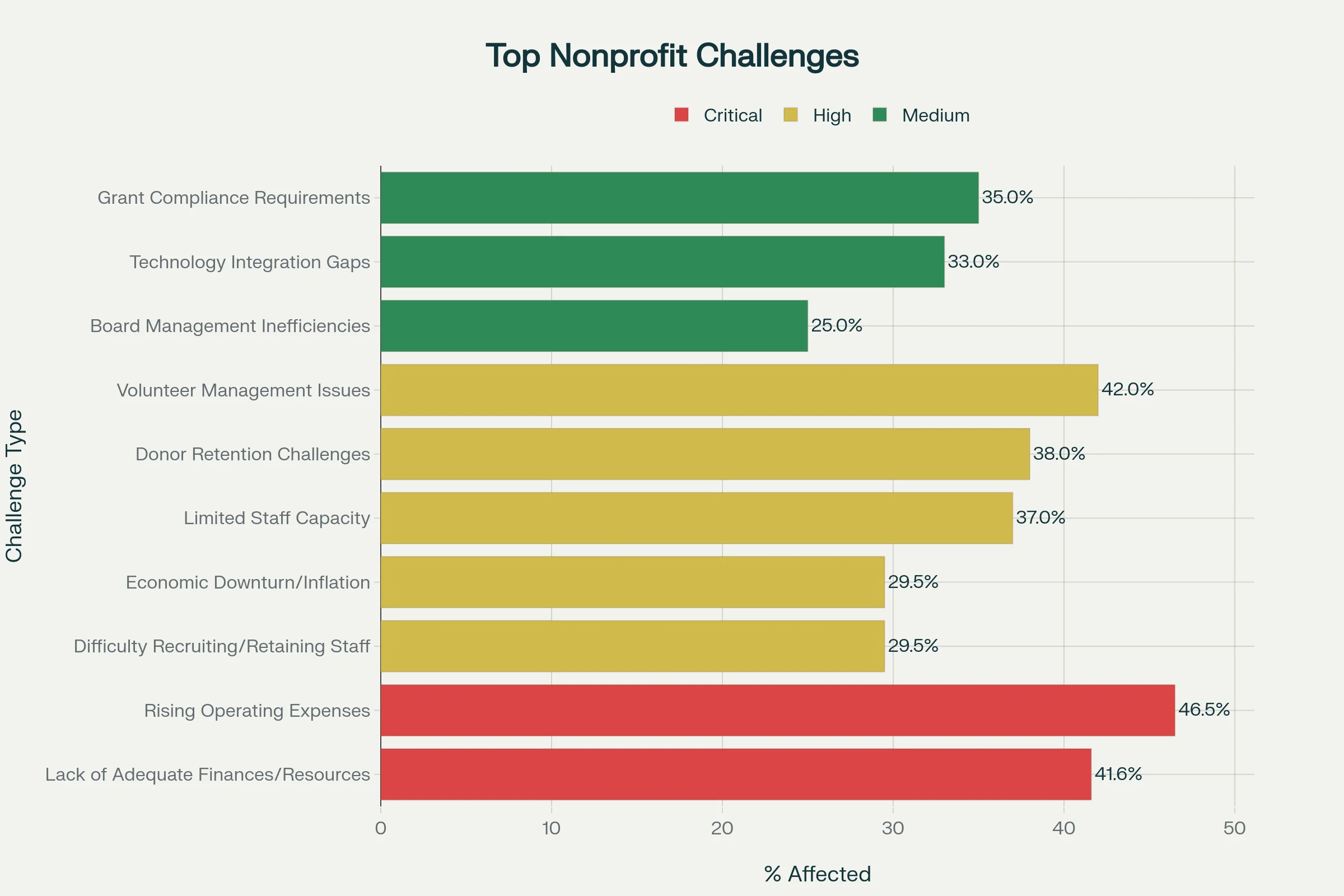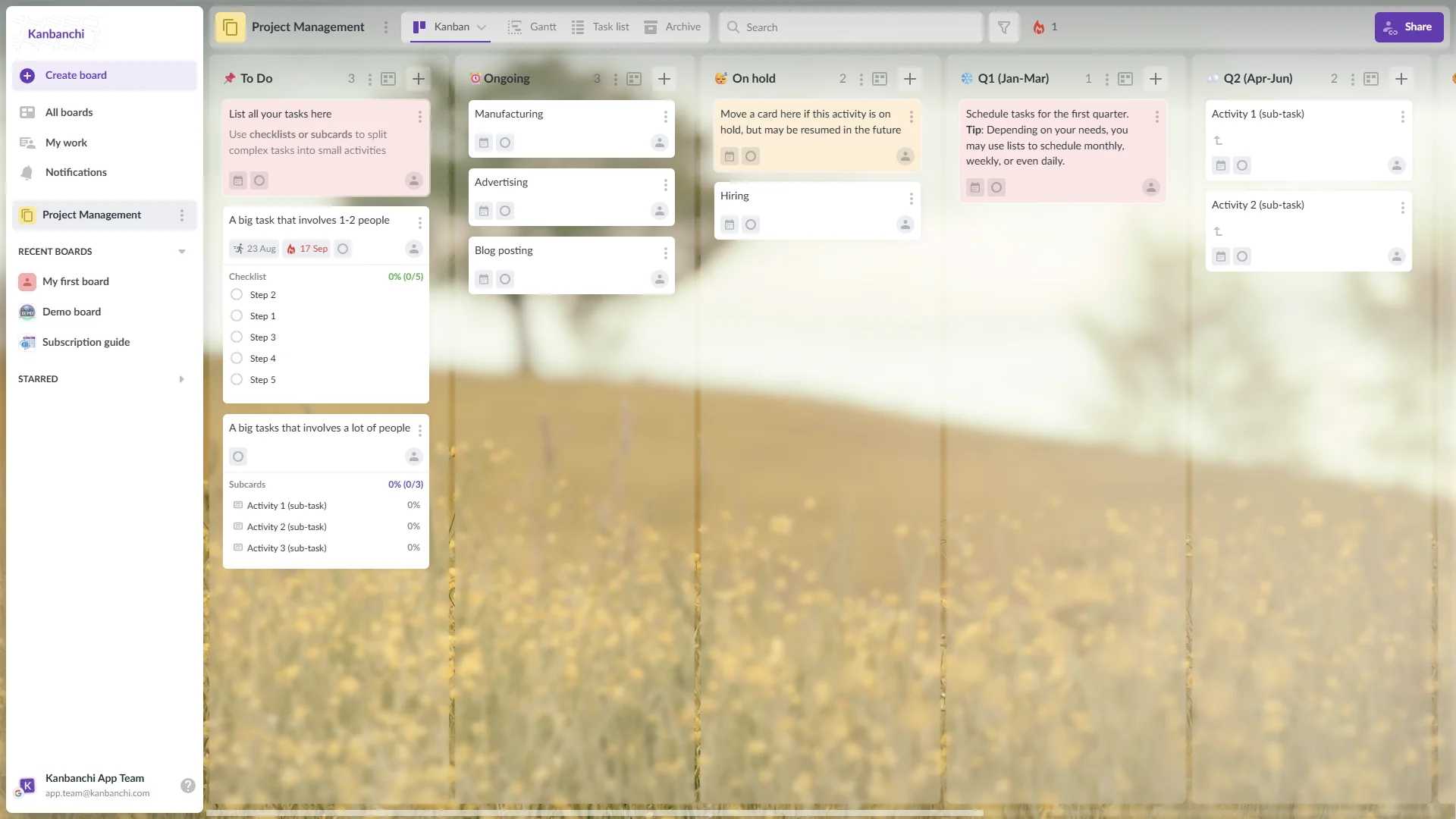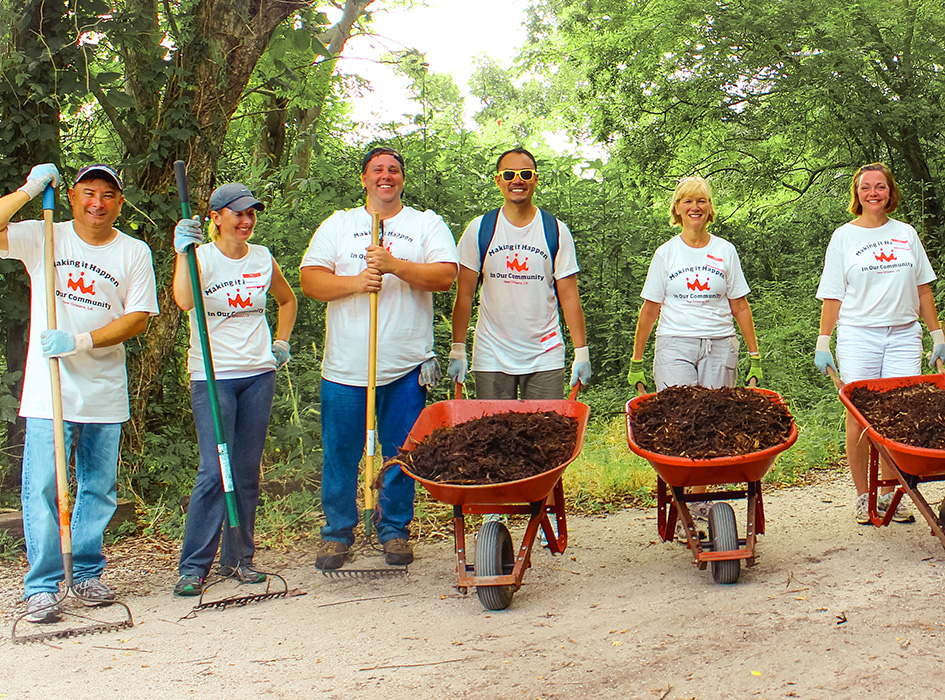In this Article:
Try Kanbanchi now
Start your free trial

Nonprofit organizations face unprecedented operational challenges in today’s rapidly evolving landscape. With 46.5% of nonprofits reporting rising operating expenses and 41.6% struggling with inadequate finances and resources, finding efficient solutions has never been more critical. Traditional project management approaches often fall short when organizations must coordinate volunteers, manage grants, track fundraising campaigns, and ensure compliance—all while maximizing every dollar toward their mission.
Nonprofit operations management has evolved beyond simple task lists and email coordination. Modern organizations need visual, collaborative tools that streamline workflows without overwhelming already stretched teams. This is where Kanbanchi emerges as a powerful solution. By implementing a comprehensive kanban for nonprofits approach, organizations can transform chaotic processes into clear, manageable workflows that improve both efficiency and mission impact.
The following guide explores how nonprofit project management software can revolutionize operations, with Kanbanchi leading the charge in helping organizations streamline nonprofit operations through visual project management, seamless Google or Microsoft integration, and nonprofit-friendly pricing that makes sophisticated project management accessible to organizations of all sizes.
Nonprofit organizations navigate a complex web of operational challenges that distinguish them from traditional businesses. Research consistently shows that 74.6% of nonprofits report job vacancies, while 68% plan to cut programs and services in the coming years. These statistics reveal the depth of operational strain affecting mission-driven organizations.
Resource constraints and budget limitations represent the most pervasive challenge. Unlike for-profit entities, nonprofits must demonstrate exceptional stewardship of every dollar while maintaining transparency with stakeholders. The nonprofit operational efficiency equation becomes even more complex when organizations must allocate at least 65-75% of expenses directly to programs, leaving minimal resources for operational infrastructure and technology investments.
Volunteer management complexities create another layer of operational difficulty. With 42% of nonprofits experiencing volunteer management issues, organizations struggle to coordinate diverse groups of supporters with varying availability, skills, and commitment levels. Traditional volunteer coordination methods—spreadsheets, email chains, and manual scheduling—often result in communication gaps, missed opportunities, and volunteer frustration.
Multiple project coordination presents unique challenges for nonprofits juggling various initiatives simultaneously. A typical organization might run concurrent fundraising campaigns, program deliveries, grant applications, and community outreach efforts. Without proper nonprofit workflow management systems, these overlapping projects create bottlenecks, resource conflicts, and missed deadlines that ultimately impact mission delivery.
Grant reporting and compliance requirements add another dimension of complexity. With 35% of nonprofits citing grant compliance as a major challenge, organizations must maintain meticulous documentation, track expenditures against specific budgets, and produce detailed reports for multiple funders—each with unique requirements and timelines.
Stakeholder communication becomes increasingly difficult as organizations grow. Board members, staff, volunteers, donors, and beneficiaries all require different types and frequencies of communication. Limited technology budgets often force nonprofits to rely on fragmented systems that don’t integrate, creating information silos and inefficient processes.

Percentage of organizations affected by nonprofit operational challenges
Kanbanchi represents a specialized nonprofit project management software solution built specifically for organizations using Google Workspace. Unlike generic project management tools, Kanbanchi integrates natively with the Google ecosystem, making it an ideal choice for the estimated 68% of nonprofits already using Google Workspace for their daily operations.
The Kanban methodology underlying Kanbanchi offers particular advantages for nonprofit environments. Initially developed for manufacturing efficiency, Kanban’s visual approach to workflow management translates perfectly to nonprofit operations. The methodology emphasizes visualizing work, limiting work-in-progress, and improving flow—principles that directly address common nonprofit challenges like resource constraints and competing priorities.
Visual project management through Kanban boards provides immediate clarity about project status, task assignments, and workflow bottlenecks. For nonprofit teams juggling multiple initiatives with limited staff, this visual approach eliminates confusion and reduces the time spent on status updates and progress tracking. Team members can instantly see what needs attention, who’s responsible for each task, and where projects stand in the overall workflow.
Google Workspace integration sets Kanbanchi apart from other nonprofit management tools. The platform stores project boards directly in Google Drive, leverages Google Calendar for scheduling, and works seamlessly with Gmail, Google Docs, and Google Sheets. This integration means nonprofit teams don’t need to learn entirely new systems or manage multiple logins—they can work within their familiar Google environment while gaining powerful project management capabilities.
Affordability and nonprofit-specific benefits make Kanbanchi particularly attractive for resource-conscious organizations. With plans starting at $3.97 per user per month and 25% discounts for nonprofits and educational institutions, the platform provides enterprise-level functionality at prices that fit nonprofit budgets. This pricing structure enables even small organizations to access sophisticated project management tools without compromising their program budgets.
Ease of use and a minimal learning curve ensure rapid adoption across diverse teams. Many nonprofit volunteers and part-time staff have limited time for training on complex software. Kanbanchi’s intuitive interface and Google-like design mean team members can become productive quickly, reducing implementation barriers and increasing overall adoption rates.
Visual boards for campaigns, programs, and events transform how nonprofit teams manage complex initiatives. Instead of relying on scattered spreadsheets and email updates, organizations can create dedicated Kanban boards for each major project. A fundraising campaign board might include columns for “Prospect Research,” “Proposal Development,” “Pending Decisions,” and “Secured Funding,” with individual donor cards moving through the workflow as relationships progress.
The visual nature of Kanban boards enables immediate status recognition across all organizational levels. Board members can quickly assess campaign progress during meetings, while staff can identify bottlenecks and reallocate resources accordingly. This transparency improves accountability and enables proactive problem-solving before issues become critical.
Task assignment and coordination becomes significantly more efficient when volunteer activities are organized visually. Organizations can create volunteer boards organized by program area, skill set, or time commitment level. Individual volunteer cards can include contact information, availability, special skills, and current assignments, making it easy to match volunteers with appropriate opportunities.
Volunteer hour tracking and activity coordination integrates seamlessly with Kanbanchi’s time tracking features. Volunteer coordinators can monitor hours contributed, track completion of required training, and ensure adequate coverage for events and programs. This systematic approach reduces last-minute scrambling and improves volunteer satisfaction through better organization and communication.
Application deadline tracking and requirement management represents one of Kanbanchi’s most valuable applications for nonprofits. Grant management boards can organize opportunities by deadline, funding amount, or program area. Each grant card can include application requirements, contact information, submission deadlines, and progress status, ensuring nothing falls through the cracks.
Compliance reporting and documentation becomes more manageable when grant-related documents and deadlines are organized visually. Teams can create workflows that move grants through stages like “Research,” “Application Preparation,” “Submitted,” “Under Review,” and “Reporting Required,” with automated reminders and task assignments keeping everyone accountable.
Donor outreach management and event planning benefits enormously from visual organization. Fundraising teams can create boards that track donor prospects through cultivation stages, from initial contact through major gift solicitation. Event planning boards can coordinate venue booking, vendor management, volunteer recruitment, and promotional activities in a single, coherent workflow.
Campaign timeline management and follow-up tracking ensures no opportunities are missed. Development staff can visualize the entire donor pipeline, identify gaps in communication, and coordinate team efforts more effectively. This systematic approach often results in improved donor retention and increased giving levels.
Deliverable tracking and outcome measurement becomes more systematic when program activities are organized visually. Program managers can create boards that track client progress, service delivery milestones, and outcome measurement activities. This approach improves program quality and provides clear documentation for reporting to funders and stakeholders.
Beneficiary impact monitoring can be integrated into program workflows, ensuring that impact measurement occurs consistently and data collection doesn’t fall behind. Teams can track individual client progress, program completion rates, and outcome achievements in ways that inform program improvements and demonstrate effectiveness to stakeholders.
Meeting preparation and action item tracking streamlines governance processes that often consume significant staff time. Board meeting preparation boards can organize agenda development, document preparation, and follow-up activities. Committee chairs can track action items, monitor completion rates, and ensure proper documentation of board decisions.
Decision tracking and implementation monitoring provides accountability mechanisms that many nonprofit boards lack. Organizations can create workflows that move decisions from “Proposed” through “Discussed,” “Approved,” and “Implemented,” with clear assignment of responsibilities and timeline tracking.
Documentation process management and audit trail maintenance becomes more systematic when organized visually. Compliance boards can track regulatory requirements, reporting deadlines, and documentation needs across all organizational activities. This proactive approach reduces compliance risks and ensures organizations maintain proper records for audits and regulatory reviews.
Report preparation and submission tracking coordinates activities across multiple departments and ensures timely completion of required reporting. Teams can visualize reporting timelines, coordinate data collection efforts, and maintain quality control processes that improve the accuracy and timeliness of required submissions.
Expense tracking and resource allocation monitoring provides financial oversight capabilities that support improved decision-making. Finance teams can create boards that track budget performance by program area, monitor expense approvals, and coordinate purchasing activities. This visual approach to financial management improves transparency and enables more responsive budget adjustments.
Financial reporting and stewardship demonstration becomes more efficient when financial activities are organized systematically. Organizations can track financial metrics, coordinate audit preparations, and demonstrate financial stewardship to donors and board members more effectively.

Time savings and efficiency improvements from implementing Kanbanchi in nonprofit operations
Initial setup and workspace creation begins with connecting Kanbanchi to your nonprofit’s Google Workspace account. The process requires only a Google account login, with no additional passwords or complex authentication procedures. Once connected, administrators can invite team members through the standard Google sharing mechanisms, ensuring everyone has appropriate access levels.
Board creation and organizational structure should reflect your nonprofit’s primary operational areas. Most organizations benefit from starting with three to five main boards covering core functions like Programs, Fundraising, Administration, and Special Events. Each board can be customized with columns that match your specific workflows—for example, a fundraising board might include “Prospects,” “Cultivation,” “Solicitation,” “Follow-up,” and “Stewardship.”
Workflow design and process mapping requires careful consideration of how work actually flows through your organization. Rather than immediately digitalizing existing processes, take time to evaluate current workflows and identify improvement opportunities. Nonprofit workflow management becomes more effective when teams can eliminate unnecessary steps and clarify decision points before implementing digital systems.
Team training and onboarding should emphasize the visual nature of Kanban methodology and how it differs from traditional task management approaches. Most nonprofit staff and volunteers can become productive with Kanbanchi within 15-30 minutes of guided training. Focus initial training sessions on basic card creation, movement between columns, and communication features rather than advanced functionality.

Kanbanchi board template that can be used to manage any type of projects including nonprofit projects
Integration setup and Google Workspace connection enables powerful automation and efficiency gains. Teams should configure Google Calendar integration for deadline tracking, Gmail integration for converting emails to tasks, and Google Drive integration for document attachment and sharing. These connections eliminate duplicate data entry and ensure information stays synchronized across platforms.
Best practices for implementation include starting small with pilot projects before full organizational rollout. Choose one program area or campaign to implement first, allowing the team to learn the system and identify potential improvements before expanding usage. This approach reduces resistance to change and enables iterative improvement of processes and workflows.
Community Learning Center, a small nonprofit serving 150 students across three locations, transformed their program operations using Kanbanchi. Previously, program coordinators relied on spreadsheets and email to coordinate tutoring schedules, volunteer assignments, and parent communication. This fragmented approach resulted in frequent scheduling conflicts, volunteer no-shows, and frustrated parents unable to get timely updates about their children’s progress.

Students engaged in a small group tutoring session
Implementation began with a single program board organized by location and program type. Tutoring sessions became individual cards containing student information, volunteer assignments, learning objectives, and progress notes. Volunteer coordinators could instantly see staffing gaps and recruit accordingly, while tutors could access session materials and update student progress in real-time.
Results achieved within six months included a 40% reduction in scheduling conflicts, 35% improvement in volunteer retention, and significantly improved parent satisfaction scores. The visual nature of the system enabled better resource allocation and identified patterns in student needs that informed program improvements.
Green Valley Conservation Society manages five concurrent conservation programs across a three-county region with 30 staff members and 200+ volunteers. Their previous project management approach involved multiple spreadsheets, weekly coordination meetings, and frequent communication breakdowns between field teams and headquarters.

Volunteers working together on an outdoor environmental conservation project
Kanbanchi implementation involved creating integrated boards for each conservation program, with shared workflows for resource management, volunteer coordination, and reporting requirements. Field teams could update project status in real-time, reducing the need for time-consuming status meetings and enabling more responsive program management.
Operational improvements included 50% reduction in coordination meetings, improved resource utilization across programs, and enhanced reporting accuracy for government and foundation funders. The organization also reported improved team morale due to reduced administrative burden and clearer communication about program priorities and progress.
Riverside Community Health Partnership operates monthly health clinics serving uninsured community members. Coordinating volunteer physicians, nurses, translators, and support staff previously required extensive email coordination and frequent last-minute adjustments when volunteers cancelled or new patients registered.

Clinic coordination boards organized volunteer assignments by role and time slot, with automated reminders and easy schedule adjustment capabilities. Patient flow management improved through visual tracking of registration, screening, and treatment stages, enabling better resource allocation and reduced wait times.
Impact measurements showed 25% improvement in volunteer scheduling efficiency, reduced patient wait times, and improved volunteer satisfaction due to better organization and communication. The organization also gained better insights into patient needs and volunteer capacity, informing strategic planning for clinic expansion.

Monthly pricing comparison of Project Management software for nonprofit organizations
Implementation planning and organizational readiness should begin with assessing current operational challenges and identifying high-impact areas for initial implementation. Conduct a brief organizational assessment focusing on pain points in project coordination, communication breakdowns, and administrative inefficiencies. This assessment will guide board creation and workflow design decisions.
Pricing information and trial offerings make getting started risk-free for nonprofit organizations. Kanbanchi offers free trials of their Enterprise plan, allowing organizations to explore full functionality before committing to paid subscriptions. Nonprofit discounts of 25% apply to annual billing, making the Essential plan available for approximately $3 per user per month for qualified organizations.
Next steps and implementation timeline should focus on gradual rollout rather than organization-wide implementation. Begin with a pilot project lasting 4-6 weeks, involving 5-10 team members working on a specific program or campaign. This approach allows teams to learn the system, identify customization needs, and build confidence before expanding usage.
Addressing common concerns about technology adoption requires acknowledging that many nonprofit team members have limited time for learning new systems. Emphasize Kanbanchi’s familiar Google interface and minimal training requirements. Most users become productive within their first session, reducing adoption barriers that often challenge nonprofits implementing new technology.
Training and support resources include Kanbanchi’s built-in help system, Google Workspace integration guides, and nonprofit-specific implementation templates. Organizations can also leverage Google’s extensive documentation and community resources, since Kanbanchi builds on familiar Google functionality rather than requiring entirely new skill development.
Mission focus and operational efficiency balance represents the ultimate goal of implementing systematic project management. By reducing time spent on coordination and administrative tasks, nonprofit teams can dedicate more energy to program delivery and mission advancement. Improved operations enable greater impact, not distraction from core organizational purposes.
The transformation from scattered, reactive operations to systematic, proactive management empowers nonprofit organizations to achieve their full potential. Kanbanchi provides the visual clarity, collaborative efficiency, and integration capabilities that enable teams to work smarter, not harder, in service of their communities and causes.
Getting started today means taking the first step toward operations that support rather than hinder mission achievement. With free trials, nonprofit discounts, and minimal implementation barriers, organizations can begin experiencing the benefits of systematic project management immediately, setting the foundation for sustainable growth and increased impact in the communities they serve.
In this Article:
Start using Kanbanchi now
Start your free trial